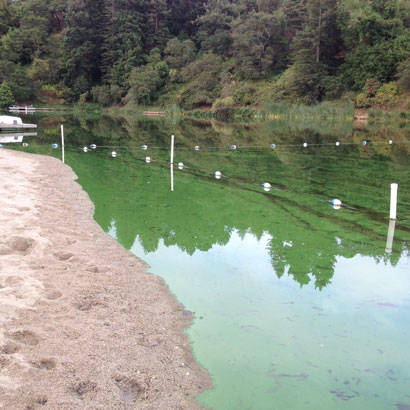
In the San Francisco Bay area, a bounty of waterfront recreation is found east of the bay. More than 25 million visitors annually enjoy fishing, kayaking and swimming throughout the East Bay in nine large bodies of water managed by the East Bay Regional Park District. However, the effects of climate change have besieged these areas in recent years: warmer temperatures and extreme changes in weather have contributed to the length and frequency of blue-green algae blooms in our recreational waters.
Blue-green algae (also called cyanobacteria) are natural organisms that are present in almost all freshwater streams, rivers and lakes. They can also be found in estuarine and marine waters. In some cases, these algae blooms may contain toxins, which, when released, can affect people and animals, either through contact with or ingestion of the toxins. Thick mats of this algae, often composed of dead algae cells, can create layers of “scum” that tend to contain the highest levels of toxin.
Warmer temperatures, increased nutrient deposition, poor circulation and low water levels have led to an increase in cyanotoxin algae blooms throughout the United States in the last decade. According to Ana Alvarez, deputy general manager for the East Bay Regional Park District, “With the rising temperatures and extended drought conditions, new to Northern California, public parklands and park users are struggling to mitigate the effects from a changing climate.”
The East Bay Regional Park District had its first recorded blue-green algae bloom in 2014. Around the country, microcystin, cylindrospermopsin, anatoxins and saxitoxins are the cyanotoxins most commonly found and each can have different health outcomes. Microcystins, for example, primarily affect the liver (hepatoxin) but can also affect the kidney and reproductive system: anatoxins are neurotoxins that affect the central nervous system. Exposure to toxic algae can result in rashes, skin and eye irritation, allergic reactions, gastrointestinal problems, and, at high doses, serious illness or death. The effects of long-term exposure are not fully known, but children and pets are at the greatest risk. Dogs are particularly vulnerable when they lick the algae off their fur after a swim. Of course, the safest approach is to avoid any contact with or ingestion of blue-green algae; however, if contact is made, rinse thoroughly with tap water and seek medical help if symptoms arise.
The East Bay Regional Park District regularly monitors its lakes for any visual indication of cyanotoxins and, where needed, samples the water to determine toxin levels. Through a variety of communication channels — posting signs, issuing news releases, updates and advisories on its website — the agency keeps visitors informed about lake conditions. It relies on recent state and federal guidelines to decide when to post swimming advisories.
Remediation Efforts
Most remediation efforts focus on nutrient reduction, with the removal of phosphorous as the key target. There are a number of possible options for remediating cyanobacteria, including physical methods, such as oxygenation of the water, or removal of sediments (dredging); chemical treatments, such as coagulants or algaecides; and biological methods such as using floating wetlands to filter and trap the nutrients and creating riparian buffers to reduce nutrients entering the water. The most effective method will depend on characteristics of the water body, including the size and depth of the surface water to be treated, and the potential effects of the treatment on recreational uses.
We strongly recommend consulting with other surface water managers and experts who have dealt similar issues and/or have applied the treatment methods in comparable situations and site characteristics, as well as working with your recreational community to ensure support of the chosen outcome.
If your park system is experiencing issues with blue-green algae or would like more information on notification and/or testing procedures for recreational water bodies, contact Hal Maclean, water management supervisor. The EPA webpage covering nutrient control and treatment, is also a good place to start your research.
Matt Graul is Chief of Stewardship for the East Bay Regional Park District. Becky Tuden is the Environmental Services Manager for the East Bay Regional Park District.

